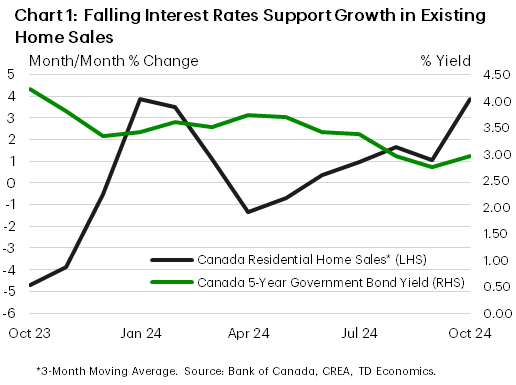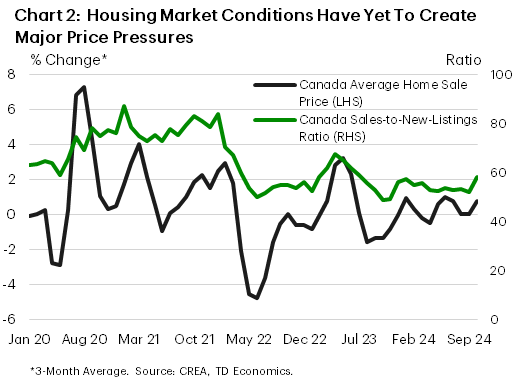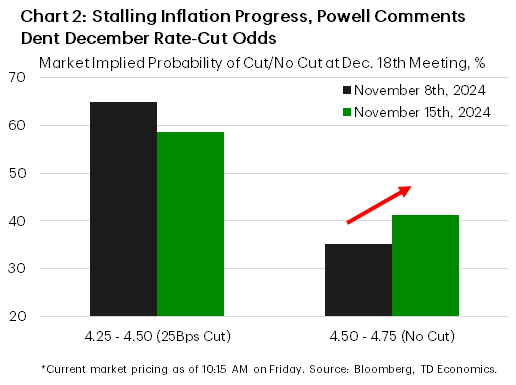Canadian Highlights
- Canada continues to digest the implications of last week’s U.S. election result, as interest and exchange rates adjust to expectations for policy changes south of the border.
- Existing home sales came in strong for a second consecutive month, a sign that interest rate cuts are starting to support the housing market.
- Next week, we will see more hard data that should shed light on how inflation and spending fared in October, which will also help inform the Bank of Canada’s December rate decision.
U.S. Highlights
- Progress on the inflation front appears to have stalled. Core CPI inflation held steady in October, while the trend over the past three months has accelerated.
- October retail sales were also solid, putting consumer spending in the fourth quarter on a very solid footing.
- Chair Powell moved markets on Thursday by saying that the Fed may not be in a hurry to cut rates. This sent Treasury yields and the dollar moderately higher, while weighing on equities.
Canada – Home Sales Begin Again
There are weeks where decades happen, and there are weeks that are just weeks. The past seven days fall into the latter, more unremarkable camp, after the U.S. election last week. Everyone, from financial markets, consumers, and heads of state, has been digesting the news as the new U.S. administration shapes up. For Canada, there is still uncertainty about what is to come, leaving most forward-looking indicators in a holding pattern. The TSX is up about 1% since the election, and long-term interest rates continue to hold at relatively low levels, with the Canadian 10-year yield still sitting around 3.2%, near where it was before the election. An exception is the CAD, which is starting to tick down towards 71 cents, the lower level we now expect for it given greater policy divergence between the Bank of Canada and the Federal Reserve.
The progress on interest rates over the past few months is starting to be felt in the economy. September’s fairly strong increase in existing home sales was more than repeated in October, where home sales spiked up 7.7% in October after trending significantly lower for most of the year (Chart 1). The relief households have received from lower interest rates is starting to return activity to this market, but it is not yet charging full steam ahead. Despite the uptick in sales, prices are not building rapidly, and the sales-to-new-listings ratio remains well below its pandemic-era peak (Chart 2). The provinces with the greatest affordability challenges, Ontario, and, to a somewhat lesser extent, B.C., still see supply-demand conditions which favours buyers, and that should continue to temper price growth in the near-term, while sales continue to get a lift from lower interest rates.
This is a story we expect to see play out in other sectors as well. In our report yesterday on Ontario’s GDP-by-industry data, we discussed the underperformance of goods-producing sectors this year. This includes the automotive sector, which is weighed down by plant retooling and interest-sensitive consumers. The retail industry in general should see a lift next year as some consumers can take advantage of declining borrowing costs. Of course, it remains a wild card what may happen if the new U.S. government pursues tariffs. This could have a significant impact on the automotive sector, especially as it is now confirmed that the Republican will have control of both Houses of Congress. We discuss the possibilities and some implications for Canada in our report last week after the election.
Next week’s data calendar is a bit more action-packed and will bring our view of Canadian data back into wide focus. We have housing starts early in the week, which should shed additional light on how lower interest rates are passing into the economy, and later in the week retail sales to check in on the consumer. The headliner is October’s inflation data, out on Tuesday, which is a critical data point for the Bank of Canada’s policy decision next month. This should help paint a clearer picture of what the Bank of Canada will do at its December 11th meeting, though at the moment, we think signs point to a 25 bps cut.
U.S. – Inflation Progress Stalls, Fed in No Hurry to Cut Rates
Political developments continued to dominate the limelight this week. Republicans retained a slim majority in the House, cementing control over both chambers of Congress and the Presidency. In the meantime, President-elect Trump is hitting the ground running, announcing cabinet appointments and White House staff positions. The choices reinforce the campaign themes of slower immigration, along with a tougher stance on China and trade. Amidst the political noise, equity markets remained sanguine early in the week, but did lose considerable steam at the end of the week on growing signs that the Fed may not be in a rush to cut rates. Chief among these are signs of slowing progress on the inflation front.
Headline inflation as tracked by the consumer price index (CPI) ticked up in October. Inflation pressures were also a little hot under the collar in the core measure, which rose 0.3% m/m for the third consecutive month. Core inflation held steady at 3.3% on a year-on-year basis in October, but the trend over the past three months heated up (Chart 1). Services inflation is showing signs of stickiness, with price growth for core services holding at 4.8% y/y for the second month in a row. This suggests that after some fast initial progress, the final stage of getting inflation back down to the Fed’s 2% target may indeed be a long slog. Producer prices drove home the same point, with growth in core producer price inflation accelerating to 3.1% y/y in October from 2.9% in the month prior.
These latest inflationary trends are not what the Fed wants to see. At a speech this week, Fed Chair Powell noted that “the economy is not sending any signals that we need to be in a hurry to lower rates”, adding that “the strength we are currently seeing in the economy gives us the ability to approach our decisions carefully”. A relatively healthy October retail sales report released on Friday lends support to that latter point. Helped along by an outsized gain in autos, decent growth in retail sales in October built on a healthy September gain to provide a solid start for consumer spending in the fourth quarter, which looks to be tracking 3.3% annualized, up from a few ticks under 3% previously.
The inflation data, combined with Powell’s comments appeared to move markets, sending yields and the dollar moderately higher, while taking a toll on equities. Market odds for the Fed to take a pause on rate cuts have surged higher in recent days, with a probability of a little over 40% (Chart 2). The next payrolls report should be pivotal for the Fed heading into the December meeting, but given that it may continue to show volatility from one-off factors (i.e., recent hurricanes), the Fed will still have its work cut out for it in trying to ascertain the underlying strength in the labor market.
Next week’s economic calendar sees updates on housing in October, which are not likely to show the impact from the recent upswing in mortgage rates yet. The starts data could be messy due to hurricane impacts, while existing home sales are still expected to be solid.

















